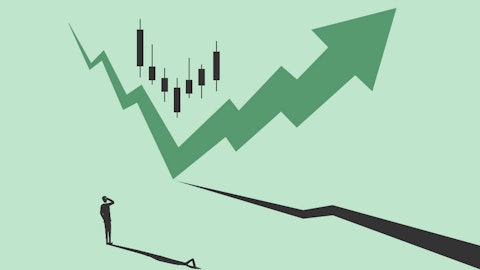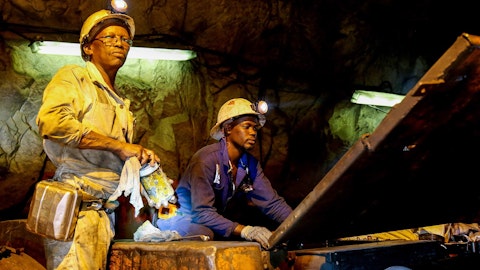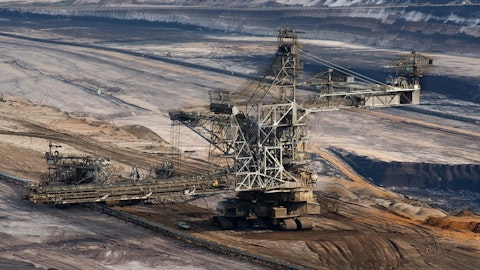John Drexler: Yeah, no good questions. I think as we look to the remainder of the year, it’s a combination of production logistics. As you guys know, all of that factors into where ultimately that volume is going to go and why we typically have that range that’s out there. But we’re comfortable with the guidance range that we have out there, and our ability to achieve it. As you step into next year, with our expectation that you’re going to see, Leer South kind of in that 3-plus million ton a year run rate, you’ve got Leer that should be comfortably above four, you’ve got the two other continuous miner operations, Beckley and Mountain Laurel executing well at a million tons a year on an annual basis. We have not provided guidance yet. We’re deep in the budget process. But I think we should be comfortably above, 9 million tons at the midpoint, as we look into ’24. And then with ongoing growth as we move further into 25, as we get into district two with Leer South.
Nathan Martin: Appreciate that, John. And then maybe also a bit of a modeling question on thermal side for the fourth quarter. I think you guys previously said roughly 60 million tons or so PRB sales. If I assume West Elk, 3.5 or 4, that gets near close to 64 million for the full year. But that would imply a pretty big step down in thermal shipments in the fourth quarter. Am my thinking about that correctly, am I missing something, any update there?
John Drexler: So I guess the midpoint of the guidance on the thermal side that we’re showing is 65 million tons. You’re at, call it 60 to 63 million tons in the Powder River Basin. You’re probably at West Elk at that number that you described, around 3 million, 3 million-plus tons. And then you also have to factor in at least on the thermal side, the mids that we show in the guidance table, which I think we’ve got 700,000 tons. So approaching a million tons on that basis is kind of what we’re expecting shipments to be.
Paul Lang: One of the things, that’s always a little bit confusing, and I think if you look back, you’ve seen the same thing last couple of quarters. We’ve guided below our sales on the thermal side. And that’s just the reality of what we were seeing earlier in the year where we thought, customers are going to ask for rollover or pushback tons. And as I say, we’re quite happy to accommodate them, as long as we achieve the same value or a little bit more. And that’s what we’re anticipating with some of that guidance.
Nathan Martin: Got it. Appreciate that, guys. And then maybe just curious, John, you’re talking about West Elk, stick with that for a second. Kind of like production in 2025 could take another step up, when you hit bigger, higher quality coal? What does that production level look like versus maybe on a more normal run rate today?
John Drexler: Yeah, so, as we worked through the challenges that we had in the Sunset district panels at West Elk, we’ve transitioned out of those. We’ve moved to another area of the reserve. The long walls gotten up and going, and things are going well there. We’ve got to manage a few things. We got some tons that we still need to ship from volumes that we missed in the first two quarters, and we’ll continue to manage that. But as we step into next year, at West Elk, our expectation is we should be around that 4 million ton a year level. And then as we step into the B seam, in 2025, there’s further opportunity with that better quality coal, more consistency in the thickness to ramp it back up to levels that we’ve seen before, at West Elk, where you’re approaching 4.5, 5 million tons on an annual basis.
West Elk, we think a great opportunity to access the export market. The coal’s well received. It’s a great quality coal into the international markets. Right now, as we look at ’24, about a third of the volume that we have is exposed to those markets. And we’re excited where West Elk is getting itself to as it moves forward.
Deck Slone: The B seam is, as John said, appreciably better quality, and you’re looking at a step up in BTUs of 400 to 500 BTUs per pound. So significant step up and appreciably better than the Newcastle sort of quality. So that’s another aspect of the story. Not only is the coal thicker, and as John said, gives us that opportunity to move back to sort of 5 million tons potentially even above that at West Elk, but also just that higher quality is going to make it that much more attractive in the seaborne market. And it’s already a really good Newcastle look alike, in fact, a little better than Newcastle.
Paul Lang: I think, what’s lost in all this is, we really view West Elk as a long term asset for the company. Its access to the seaborne market, particularly what’s going into Asia, based on Newcastle pricing is really pretty exciting. Say the B seam we’ve got a lot of experience mining the B seam, and when we get down to it, it’s excellent, the quality goes up considerably and it’s a very good product and it gives a lot of advantage, in particular the Japanese markets.
Nathan Martin: Great color there guys. And if I may, just one more. Don’t want to leave Matt out. What’s kind of driving the CapEx increase, about $10 million at the midpoint? I think Matt, you mentioned some CapEx to occur in the fourth quarter. But is there anything particular there to note?
Matthew Giljum: A lot of that Nate really is just timing. And I’ll let John chime in, if he’s got anything to add. A lot of it is just timing of when we receive things. Obviously with some of the supply chain lags that we’ve seen, trying to predict when those things are going to arrive certainly is not as easy as it once was. The other thing I would mention is we are bringing on some additional equipment, as we look into next year, trying to find opportunities to expand production, where it makes sense as we go into the 2024 timeframe.
John Drexler: Yeah, I think Matt said it well. You can get a little lumpy here, when you’ve got some lead time items that are 18, 24 months out trying to predict exactly when they’re going to come in is difficult. So we’re glad to get some of the stuff that we got. We’ll get it in place. I think we’ve discussed in the past, as we move forward, and we’re not providing specific guidance yet, but we would expect future years of CapEx to be in similar ranges to what we’ve seen in the last couple of years as well. So we feel good about kind of how we’re managing all that and moving forward.
Nathan Martin: Very helpful, guys. Appreciate the time. Best of luck in the fourth quarter.
John Drexler: Appreciate, Nate.
Operator: The next question comes from Michael Dudas of Vertical Research Partners. Please go ahead.
Michael Dudas: Good morning, gentlemen.
John Drexler: Hey, Michael.
Michael Dudas: So Paul, I think is very appropriate to be cautious on outlook for U.S. thermal consumption, regarding your PRB assets. But maybe can you remind us, over the next, how do you look at the mine plans over the next 5 to 10 years, given what maybe you would have thought when you instituted your reclamation, and your [indiscernible] plan, relative to what consumption’s been, what utility customers are saying. I mean, there’s been — even though they’ve talked about net retirements in coal, there’s been some plants that need to stay on for grid and other type reasons. So is there a chance that maybe you can accelerate some of those future cash flows into some of the near term years, and given where your plan is right now maybe what your customers are thinking, recognizing that you want to be cautious on expectations on thermal demand?




